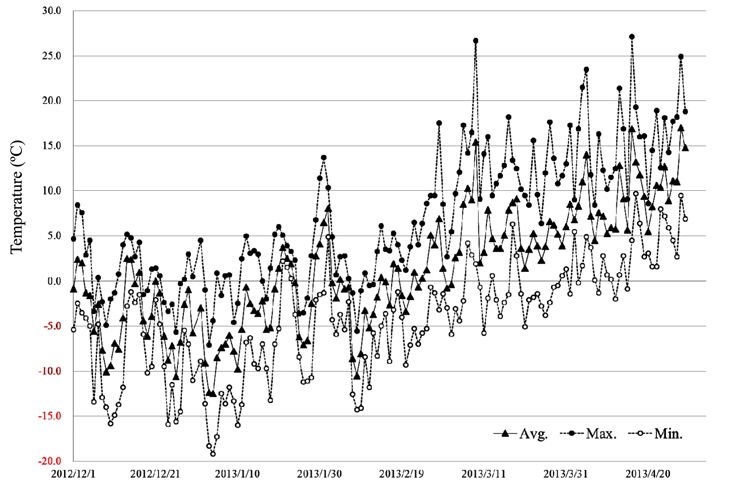



Optimum temperature ranges for turfgrass growth are various based on turfgrass species. Appropriate temperature ranges are 18 to 24℃ for shoots and 10 to 18℃ for roots of cool-season grasses. In warm-season grasses, optimal temperature ranges are 27 to 35℃ for shoots and 24 to 29℃ for roots (Beard, 1973). When temperature is decreased or increased outside proper temperature range for turfgrass growth, temperature stress or injury occurs. Turfgrasses are damaged or killed during winter due to the single or multi effects including freezing stress, traffic, desiccation, soil frost-heaving and low-temperature fungi (Beard, 1973). Winter turfgrass injury is one of the critical problems of many golf courses in Korea. Winter stress to turfgrass is mainly caused by tissue desiccation, direct low temperature, disease and traffic stress (Trenholm, 2000). Turfgrass loss from freezing injury due to low temperature also leads to weed invasion and herbicide cost, increased soil erosion, and expensive re-establishment (Dipaola and Beard, 1992). Among winterkill stress, chilling stress is induced at low temperature from 0 to 12℃ in late fall or early winter. Due to lower fall temperatures and shorter day lengths, warmseason grasses enter a dormancy and become brown or dead shoot tissue which is not necrotic to kill the turfgrass. Compared to chilling stress which is mostly associated with bermudagrass (
Although freezing injury in cool-season grasses is not as serious concern as in warm-season-grasses, freezing injuries to cool-season grasses have been reported in previous researches. Turfgrasses which are the most low temperature sensitive are annual bluegrass (
Protecting the turfgrass crown is necessary for recovery from low temperature stress in winter because shoots and roots can be recovered from the crown (Fry and Huang, 2004). Turf covers may help protect the crowns from direct low temperatures and desiccation. Tompkins et al. (2000) reported that it is important to keep turfgrass covered with snow in order to maintain dormancy for as long as possible. Snow can be a constant source of moisture and insulator for higher temperature than air temperature (Happ, 2004). Not only snow, but various types of protection covers are routinely applied to protect turfgrass from low temperature and moisture stress, and to enhance turf establishment. Roberts (1986) reported that polyester, polypropylene, and pine needle covers have reduced winter desiccation, and polyester blankets have enhanced spring green-up of creeping bentgrass. Tapp et al. (1988) reported that straw, polypropylene or polyester covers improved turfgrass quality and spring green-up for bermudagrass compared without covers. Dionne et al. (1999) found crown temperature of annual bluegrass was raised minimum low temperature with applications of curled wood mat, straw mulch, and a 5-cm air pocket under an impermeable cover. Johnston and Golob (1997) reported that winter desiccation problems on a putting green comprised of creeping bentgrass and annual bluegrass was reduced with turfgrass cover. However, turf cover may have negative effects for turfgrass growth when impermeable materials to water and gas are used because anoxia condition and accumulation of CO2 has been shown to have potential phytotoxic effects (Andrews and Pomeroy, 1989; McKersie and Leshem, 1994).
Although winter injuries to turfgrass are common on many golf courses in Korea, we are unaware of in situ researches that studied the effects of turf cover to protect turfgrass from multi factors of winter injuries. The objective of the study was to evaluate various turf covers including permeable and impermeable materials for Kentucky bluegrass during winter.
On April 2012, Kentucky bluegrass ‘Unique’ was established from seed at the Hoseo Turfgrass Research Center on the campus of Hoseo University, Asan, Korea. The study was initiated on December 5, 2012 with turf cover application and turf was coverd by turf cover treatments until the end of the study. Before the initiation, Kentucky bluegrass was mowed at 5 cm. Six different turf covers were installed to cover Kentucky bluegrass during a period of low temperatures. Clear poly-vinyl chloride (PVC) film and black woven polypropylene with 30% light-pass through (BWP) were used for treatments. The clear PVC film was used with two types which had holes of 1 cm diameter and 5 cm between holes and had no holes. The BWP was used as BWP treatment and combined with each types of clear PVC film for treatments of combination turf covers. For the complete list, treatments of turf cover were described in Table 1. Kentucky blugrass plots were maintained with no artificial irrigation, no fertilizer applications, and no mowing events during the study period. Each plot size was 0.8×1.2 m. Minimum and maximum temperatures when plots were covered with turf cover treatments were -5℃ and 4.5℃, respectively. Data collection included turfgrass color and quality. Turfgrass color and quality were measured by visual evaluation based on National Turfgrass Evaluation Program guideline and were measured from March 14, 2013. Seasonal turf color ratings are a measure of overall plot color (NTEP, 2011). Turfgrass color was measured by an index of damage caused by disease or insect pests, nutrient deficiency or environmental stress. Turfgrass color was visually rated on a scale of 1 to 9 (1 = straw brown, 6 = acceptable, and 9 = excellent) every two weeks. Turfgrass quality was measured by an index of turf density, leaf texture, disease resistance, mowing qualities, and stress tolerance including several stresses during winter (Beard, 1973; Turgeon, 1999). Turfgrass quality was visually rated on a scale of 1 to 9 (1 = poor, 6 = acceptable, and 9 = best) every two weeks. Leaf and root length were measured to estimate growth on April 4 and 26. Leaf and root length were averaged over three measurements for each plot
[Table 1.] Treatment list of turf cover.
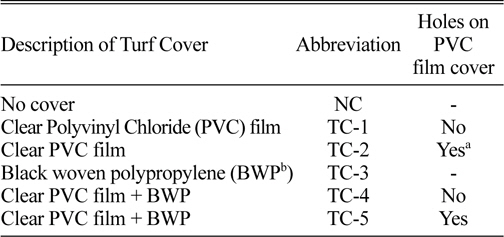
Treatment list of turf cover.
The experimental design was a randomized complete block design with 3 replications with 6 treatments. Treatment differences were analyzed by the Proc Mixed procedure. When appropriate, mean separations were performed by Fischer’s protected least significant difference (LSD) at a 0.05 probability level. All statistical analyses were analyzed by SAS (SAS Institute Inc., 2001).
There were significant turf cover effects for turfgrass color (Table 2). The TC-4 had the highest or equal to the highest turfgrass color ratings from March, 14 to April 4. After April 4, the TC-4 had the lowest or equal to the lowest turfgrass color ratings. There is no difference between TC-1 and TC-2 from March, 14 to April 4. The TC-3 had higher turfgrass color ratings than the TC-2 after April 4. The TC-3 had the highest or equal to the highest turfgrass color ratings from after March, 27. On April 4, there is no differences among treatments for turfgrass color except the NC. The NC which is uncovered control had turfgrass color ratings less than acceptable color rating of six from March, 14 to April 4. The NC-4 had higher turfgrass color than the TC-5 on March, 14 and 27. No difference between the TC-4 and TC-5 color ratings of six on May 6. When average air temperature reached 11.0℃ on April 4, no difference was found on turfgrass color except NC. The temperature difference between air and under cover was 3.1 to 8.7℃ based on different types of turf cover (date not shown). On April 4, the range of daily average temperature under cover was 14.1 to 19.7℃. This temperature range is similar to the values by Beard (1973) for optimum temperature range for coolseason grasses. Regardless of turf cover types, all treatments had turfgrass color higher than acceptable turfgrass color of six with the temperature range of under turf cover until April 4. Compared to the NC which is uncovered plot, all turf types of turf cover had positive effects for turfgrass color until daily air average temperature reached 11.0℃. However, the combination of clear PVC film and the BWP had turfgrass color lower than acceptable turfgrass color of six on April 26, and the average air temperature was 11.1℃. On May 6, all treatments except the NC had turfgrass color lower than acceptable turfgrass color of six, and the average air temperature was 14.1℃. After April 26, the turf cover had negative effects for turfgrass color as temperature increase. On May 6, the temperature rage under turf cover was 27.5 to 38℃.
[Table 2.] Mean turfgrass color for turf cover main effect.
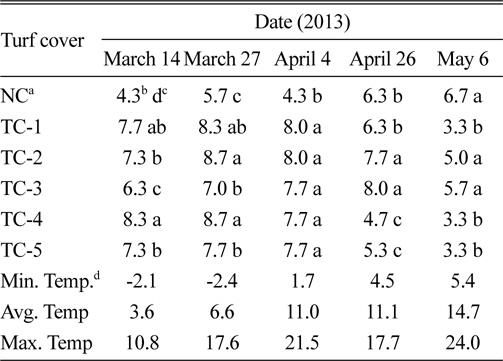
Mean turfgrass color for turf cover main effect.
There were significant turf cover effects for turfgrass quality (Table 3). The TC-4 had the highest or equal to the highest turfgrass quality ratings from March, 14 to April 4. No differences were found on April 4 except the NC. The TC-3 had the highest turfgrass quality on April 26 and equal to the highest turfgrass quality on May 6. There were no differences between the TC-1 and TC-2 during the study period. Holes on turf cover didn’t affect the turfgrass quality.
[Table 3.] Mean turfgrass quality for turf cover main effect.
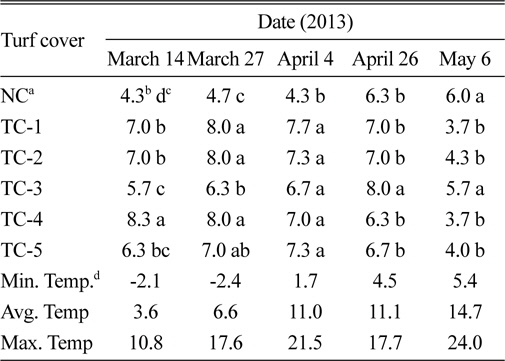
Mean turfgrass quality for turf cover main effect.
No differences were found between the TC-4 and TC-5 for turfgrass quality except the rating day on March, 14. The combination of clear PVC film and BWP didn’t have significant effects for turfgrass quality except the rating day on March, 14. On April 26, all of the treatments had turfgrass quality higher than acceptable turfgrass quality of six. The NC had turfgrass quality higher than acceptable quality of six after April 4. Compared to the NC, all of the treatments except the NC had turfgrass quality lower than acceptable turfgrass quality of six after April 26. Turfgrass was positively affected by turf cover. The uncovered plot had unacceptable turfgrass quality until April 4. The average and maximum air temperature on April 4 were 11.0 and 21.5, respectively. The temperature under turf cover was 15.4 to 23.1℃. Although it was proper temperature range for cool-season grasses, the NC had unacceptable turfgrass quality until April 4. It may be affected from the period of low temperature without the protection of crown. According to Anderson et al. (2003), temperature fluctuation had more effects than low temperature for turfgrass quality. The difference between maximum and minimum air temperature during the study period was 2.4 to 24.8℃ (Fig. 1). The temperature fluctuation may affect turfgrass quality until April 4. On May 6, all of the turf cover treatments except the TC-3 had lower turfgrass quality than the NC. The TC-3 had turfgrass quality lower than acceptable turfgrass quality of six on May 6. When the NC had higher turfgrass quality than turf cover treatments, daily average air temperature was 14.7℃. Kentucky bluegrass with turf cover resulted in chlorosis symptoms on leaves due to higher temperature. It is supported by Dernoeden (1998) who reported that the chlorosis develops in response to abrupt temperature or relative humidity changes. Maximum air temperature was increased from 17.7℃ on April 26 to 24.0℃ on May 6. The temperature range under turf cover was 27.5 to 38℃.
There were significant turf cover effects for leaf and root length (Table 4). All turf cover treatments except the TC-3 produced longer leaf length than the NC on April 4. No differences were found on April 26 for leaf length. The TC-1 and TC-3 produced the longest root length on April 26. All turf cover treatments except the TC-1 and TC-3 produced shorter root length than the NC. The TC-1 which is clear PVC film without holes had longer root length than the TC-2 which is the clear PVC film with holes.
[Table 4.] Mean turfgrass leaf and root length for turf cover main effect.
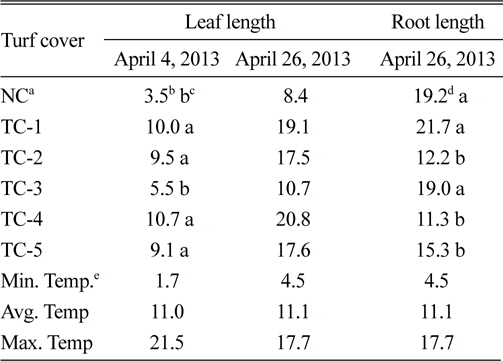
Mean turfgrass leaf and root length for turf cover main effect.
Because the temperature under turf covers was 3.1 to 8.7℃ higher than air temperature, turfgrass can be stressed with high temperatures when temperature under turf covers is increased higher than optimum temperature. Based on the study, negative effects were found after April 4. In addition to temperature, multi factors may affect negatively to Kentucky bluegrass. Goatley et al. (2007) reported that turf covers reduce the level of photosynthesis at the surface level which lead to limit spring regrowth. However, the benefits of spring green-up by turf covers have been reported (Sowers and Welterlen, 1988; Schmidt et al., 1989). Overall, turf covers had positive effects for spring green-up of Kentucky bluegrass based on the study. Although the NC had unacceptable turfgrass quality on March, 14, all turf cover treatments had acceptable turfgrass quality. Applying any type of turf covers on Kentucky bluegrass resulted in an increase in an average and minimum temperature under turf covers compared to the uncovered plot. Therefore, turf covers enhanced the growth and spring green-up of Kentucky bluegrass during a period of low temperatures. Among turf covers treatments, clear PVC film without holes produced the longest root length and the highest turfgrass quality. The BWP maintained the highest turfgrass quality until April 26 with the longest root length. If there is a need for rapid spring green-up of Kentucky bluegrass, clear PVC film without holes may be the type of turf cover according to the results of the study. Further research is needed to evaluate and compare timings of turf cover installation. Temporary or permanent turf covers may have different results.



